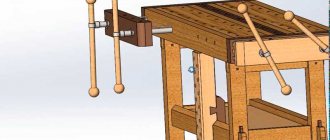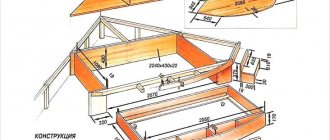Required tools and materials
Studs Cables Hooks
A person is not very strong for lifting large loads, but he has come up with many mechanisms that simplify this process, and in this article we will discuss pulleys: the purpose and design of such systems, and we will also try to make the simplest version of such a device with our own hands.
- 2 How does a simple block design work?
- 3 Complex block system - how to calculate the gain in strength?
- 4 Rope and its role in the operation of the pulley system
- 5 Methods of attaching a rope to a lifting mechanism
- 6 We create the simplest lifting mechanism with our own hands
Inexpensive mini lift
Practice shows that when building a private house, a real crane is not always needed. Often, a developer can get by with “little expense” and make a small lift based on an electrically driven hoist.
My design is simpler than the authors above, but it suits me quite well. I bought a hoist with a load capacity of 300 kg without a block and 600 kg with a block. Tests have shown that the device can lift a load weighing 250-270 kg, then the engine protection is triggered. During the construction season, I used it to lift about 40 pallets with building blocks, a 6-meter beam for the mauerlat, rafters, mortar for masonry and concrete for the reinforced belt.
The lift, again to save money, is made from used pipes, angles and channels.
Read also: Cool homemade crafts for the home
All rust was cleaned off with a grinder, and the pipes were sprayed and then painted with paint with a rust reducer.
In order to be able to assemble the lift on the ceiling of the second floor, all components (where welding is not needed) are made dismountable - with bolted connections.
A hoist is installed on the stand using clamps.
In case of rain, a plastic bottle with the bottom cut off is placed on the control panel.
The telpher covers a canopy made of used roofing iron.
When lifting a pallet, two boards are placed under it, and the pallet is lowered onto them.
The entire structure is fixed to the floor with clamps.
Drawing with dimensions of the lift.
These are topics that describe in detail how to make a lift for aerated concrete, and provide dozens of options for mini-cranes, from simple to the most complex designs.
Many people believe that building a house from 6-meter timber alone is a fantasy task. Nevertheless, it is quite possible to do this, but you will have to use an assistant crane, which is quite possible to build yourself.
Since the wooden beam is quite bulky and heavy, it will be quite difficult to lift it yourself. With the help of a crane, in turn, the timber can be placed at the cutting site, and also, with the help of its functions, you can quite successfully lift the sawn timber onto the base of the house.
Any type of scrap metal is suitable for the frame of a homemade crane. At the same time, it can be made from ordinary corners measuring 63x63x5 millimeters.
A five-meter pipe with a diameter of 50 millimeters was used as an arrow; also, the design feature implies that in the future it will be possible to extend the arrow by several meters. This design is reinforced with metal corners 30x30x3.
The maximum weight lifted by the crane is 150 kilograms. However, the design feature of this crane allows it to lift loads weighing half a ton, but for this it will be necessary to increase the multiplicity of the pulleys.
The principle of operation of the pulley is similar to the operating features of the gearbox: to achieve greater power, it is necessary to provide the appropriate length of the rope, which, accordingly, will need much more. As a result, the speed of lifting the load will slow down, but the crane will be able to lift much more.
One of the main characteristics of the gearbox is the gear ratio; the pulley, in turn, must have a multiplicity - the ratio of the number of “rings” on the cable with those running off the drum. Based on this, in the case when 5 turns are wound on a homemade crane, the pulley is fivefold. In other words, lifting a half-ton load requires the same force as lifting a 100-kilogram load.
What is special about a homemade lifting mechanism?
It is worth noting that the manufacture of all components and mechanisms of a homemade assistant crane is a labor-intensive and tedious process, requiring a huge amount of time. Thus, it will take at least a week to manufacture all the components of the faucet, and it will take another two to three days to assemble the finished device and calibrate it. A six-fold pulley was used as a rotation drive, and the boom lift drive, in turn, was represented by a double mechanical pulley.
Specifically in this device, the rotating platform is made of two faceplates, and the crane itself was assembled from scrap materials, so it is not surprising that its axis is 30 mm. a bolt made of steel that does not have high strength. This decision is due to the fact that high-strength steel is practically impossible to weld: if the tensile strength is exceeded, such a bolt immediately bursts, it can neither be stretched nor bent. It is advisable to lubricate the components of a homemade faucet with a small amount of lithol. To reduce the weight of the counterweight, 2-meter support legs are installed in the crane.
When calculating the components in the manufacture of this device, it is necessary to take into account that with the average radius of the part responsible for the rotation, as well as the distance to the counterweight with the specified mass, a tensile load will act on the main bolt (which, naturally, will be much greater during operation). Before using the crane, you must carefully check the stability indicators.
Blocks for the lifting mechanism can be made from two large and one small washers. Such blocks will be stable. It is extremely important that the cable has the necessary flexibility, or that the blocks themselves have a diameter corresponding to the rope, because when lifting the boom without a load, the rope can fly out of the block, which will be very unpleasant.
A thick cord with a diameter of 15 mm was used as a cable. It is planned that in case of extension, a more flexible 5 mm one will be installed on the tap. cable with a working load of 150 and a breaking load of 850 kg. Such a crane allows you to build a log house almost single-handedly, as well as do a huge amount of other construction work.
How do we make lifting easier?
A cargo pulley is a system consisting of ropes and blocks, thanks to which you can gain effective strength while losing in length. The principle is quite simple. In length we lose exactly as many times as we win in strength. Thanks to this golden rule of mechanics, you can lift large loads without exerting much effort. Which, in principle, is not so critical. Let's give an example. Now you have won 8 times in strength, and you will have to stretch a rope 8 meters long to lift the object to a height of 1 meter.
The use of such devices will cost you less than renting a crane, and besides, you can control the gain in strength yourself. The pulley has two different sides: one of them is fixed, which is attached to the support, and the other is movable, which clings to the load itself. The gain in strength occurs thanks to the movable blocks, which are mounted on the movable side of the pulley. The fixed part serves only to change the trajectory of the rope itself.
Types of pulleys are distinguished by complexity, parity and multiplicity. In terms of complexity, there are simple and complex mechanisms, and the multiplicity means a multiplication of force, that is, if the multiplicity is 4, then theoretically you gain 4 times in strength. Also rarely, but still used, a high-speed pulley block is used; this type gives a gain in the speed of moving loads at a very low speed of the drive elements.
Electric traction
Nowadays, in lifting equipment, along with muscle power, electric traction is also widely used; it allows you to save physical strength for other work. The speed of transportation using electric lifting equipment is much higher than with manual labor, which leads to a significant reduction in construction time. However, with small volumes of work, the cost of lifting devices operating from the network is sometimes not adequate to the gain obtained. And there is not always electricity available at a construction site, at least in excess of capacity.
Read also: Replacing brushes on a Hitachi screwdriver
How does a simple block design work?
Let's first consider a simple assembly pulley. It can be obtained by adding blocks to a support and a load. To get an odd mechanism, you need to secure the end of the rope to a moving point of the load, and to get an even one, we fasten the rope to a support. When adding a block, we get +2 to strength, and a moving point gives +1, respectively. For example, to get a pulley for a winch with a multiplicity of 2, you need to secure the end of the rope to a support and use one block that is attached to the load. And we will have an even type of device.
Reliability and safety
In addition to cost, there are two more factors that cast doubt on the feasibility of making a lifting mechanism for a car with your own hands - reliability and safety. The weight of even a small car often exceeds one ton.
A car may fall off a lift for the following reasons:
- the weight of the machine turned out to be more than the drive or actuator can support;
- the locking device turned out to be of incorrect design;
- the locking device could not withstand the load;
- The lift supports are insufficient or incorrectly secured.
To make a lift with your own hands, you have to either take a ready-made diagram, hoping that its author has carefully calculated the strength of all the parts, or carry out these calculations yourself. Only a highly qualified engineer can do this kind of work; an ordinary car enthusiast cannot do it. In addition, it is necessary to calculate how much load the drive and brake mechanism can withstand. If any of these calculations are made incorrectly, the car lift turns into a deadly trap. No less important is the calculation of the basis of this mechanism. It is not enough to simply pour a thick layer of concrete, because it is necessary to provide fastenings located in strictly defined places.
Important Domestic light-duty truck ZIL-5301 Bychok with more than 35 modifications
Read also: Voltage stabilizer 220V photo
Search for parts
If you nevertheless decide to build a car lift with your own hands, and you are not afraid of the dangers of this homemade product, then start selecting parts by searching for the drive mechanism and stopper. These parts can be found in the following places:
- stores selling components for special equipment;
- enterprises that have old construction equipment on their balance sheet;
- enterprises that are updating their fleet of woodworking or metalworking machines;
- collection points for ferrous and non-ferrous metals.
For a scissor lift, you will need two hydraulic cylinders of suitable power and length, a compressor for them, and hydraulic hoses. The scissor circuit is the easiest to manufacture, but it is impossible to make a reliable brake in it. Therefore, if a hose bursts or one of the cylinders leaks, trouble cannot be avoided. Shafts and electric motors with gearboxes suitable for platform or fork lifts are easiest to find where old machines are replaced with new ones. This will cost much less than ordering worms from a turner. And the stopper of such mechanisms is not complicated - a helical bar with a lock, made of steel 1-2 cm thick.
Conclusion
If you still decide to take a risk and make a car lift with your own hands, then before choosing any scheme and starting assembly, find those who have already made such a device. See how it works, make sure it is safe. After all, you are not risking your car, but your life. If, when the car falls, one of your family members is under it with you, then you will put his life at risk.
To service a car in a service station, a bunch of special equipment is used, from cheap to very expensive, completely inaccessible to a private technician or simply a vehicle owner who is used to servicing the car with his own hands. There are very highly specialized devices that can be useful to a private owner once or twice a year. And there are those without whom any repair or prevention is simply impossible. Car lifts are just that case.
Complex block system - how to calculate the gain in strength?
Now we will find out how a complex type chain hoist works. This name refers to a mechanism where several simple versions of this cargo device are connected into one system; they pull each other. The gain in strength of such constructions is calculated by multiplying their multiplicities. For example, we pull one mechanism with a multiplicity of 4, and another with a multiplicity of 2, then the theoretical gain in force will be equal to 8. All of the above calculations take place only for ideal systems that have no friction force, but in practice things are different .
In each of the blocks there is a small loss in power due to friction, since it is still spent on overcoming the friction force. In order to reduce friction, it is necessary to remember: the larger the bend radius of the rope, the less frictional force will be. It is best to use rollers with a larger radius where possible. When using carabiners, you should make a block of identical options, but rollers are much more effective than carabiners, since the loss on them is 5-30%, but on carabiners it is up to 50%. It is also useful to know that the most effective block must be located closer to the load to obtain maximum effect.
How do we calculate the real gain in strength? To do this, we need to know the efficiency of the units used. Efficiency is expressed as numbers from 0 to 1, and if we use a rope with a large diameter or too stiff, then the efficiency of the blocks will be significantly lower than indicated by the manufacturer. This means that it is necessary to take this into account and adjust the efficiency of the blocks. To calculate the actual strength gain of a simple type of lifting mechanism, it is necessary to calculate the load on each branch of the rope and add them up. To calculate the gain in strength of complex types, it is necessary to multiply the real forces of the simple ones of which it consists.
Lift for laying aerated concrete blocks
Abroad, during the construction of private houses, cranes and various lifts are often used. This way construction goes faster, which means the “box” is cheaper, because It is more profitable to use small-scale mechanization tools than to hire laborers. Our developer relies on himself and often builds a house “with one helmet.” Therefore, the urgent question is how not to physically overstrain yourself when laying a wall from aerated concrete blocks weighing 35-40 kg.
An interesting option is the unusual homemade “assistant” of the FORUMHOUSE user with the nickname Krestik. First, let's show what he took as a basis.
German mini crane with retractable central post
A special feature of the lift is the original folding “arm-boom”, with the help of which the crane, moving on wheels, can reach two opposite walls.
Read also: Wiring diagram for a two-key switch with four light bulbs
I am building a house myself and, in order to be able to lay aerated concrete blocks, I built a lift according to the above model. The crane was made completely collapsible, except for the base. I didn’t measure the maximum load on the hook, but it easily lifts me (weighing 95 kg).
Technical characteristics of the lift:
- width – 2200 mm;
- height – 4200 mm;
- boom radius – 4200 mm;
- load capacity of electric hoist – up to 800 kg;
- total weight of the crane with ballast is approximately 650 kg;
- lift weight without ballast – about 300 kg;
- The maximum lifting height of the masonry block is 3500 mm.
The working height of lifting blocks is adjustable in two ranges. The first is 1750 mm. The second is 3.5 m, for which the structure is raised, sliding upward along the supporting “legs” using a hydraulic jack lined with spacers made of GB blocks.
To make the lift, the user needed:
- swivel wheels;
- profile pipes for the mast, “legs” and boom with a section of 12x12 cm, 12x6 cm, wall 6 mm;
- pipe-jibs – 63x3 mm;
- powerful gate hinges;
- The boom rotating mechanism is made of ST45 steel and “205” bearings.
During operation, the design was modified. For example, the user laid the cable for the winch in a corrugated pipe and extended the cable for the control panel.
The design has a number of shortcomings that I would like to correct. For example, I’m thinking about making wireless control, replacing the gate hinges with bearings. Increase the number of “joints” in the boom at the same reach. Instead of a temporary counterweight - bags of sand concrete, pour concrete ballast.
Important nuance : in order for the lift to move around a construction site or, for example, on a concrete floor slab on the second floor, you need to keep the workplace clean, because GB fragments and debris interfere with the relocation of the tap.
The design of the unusual lift attracted the interest of portal users.
With such a lift, I think, as they do in Germany, you need to make masonry from blocks larger than standard ones. The length and height are 2-3 times greater than a regular GB. The crane has enough lifting capacity, and the laying speed will increase significantly.
According to Krestik, he heard that someone on the portal had already tried to order blocks of 1x0.4x0.6 m format from a gas silicate manufacturer. But it turned out that this was not profitable for the plant, because it is necessary to reconfigure the line for the production of GB, but for the sake of a small volume (for an ordinary private house) they will not do this.
I'm wondering: is the work on site easier when using a crane? What work can be done with it and what cannot?
There is no need to install scaffolding when laying GB walls. The lift can be assembled and disassembled. I poured the concrete lintels over the windows the old fashioned way, from buckets, because... The volume is small, and it’s easier to do it with one assistant.
The overall result: the mini-crane turned out to be successful, and with some modifications to its design, the lift can be put into small-scale production.
Rope and its role in the operation of the pulley system
You should also not forget about the friction of the rope, since its branches can twist among themselves, and the rollers under heavy loads can converge and pinch the rope. To prevent this from happening, the blocks should be spaced relative to each other, for example, you can use a circuit board between them. You should also purchase only static ropes that do not stretch, since dynamic ones give a serious loss in strength. To assemble the mechanism, either a separate or a cargo rope can be used, attached to the load independently of the lifting device.
The advantage of using a separate rope is that you can quickly assemble or prepare a lifting structure in advance. You can also use its entire length, this also makes it easier to pass knots. One of the disadvantages is that there is no possibility of automatic fixation of the lifted load. The advantages of a cargo rope are that automatic fixation of the lifted object is possible, and there is no need for a separate rope. The important thing about the disadvantages is that it is difficult to pass through the knots during operation, and you also have to spend a cargo rope on the mechanism itself.
Let's talk about the reverse motion, which is inevitable, since it can occur when the rope is caught, or at the moment of removing the load, or when stopping to rest. To prevent backlash from occurring, it is necessary to use blocks that allow the rope to pass in only one direction. At the same time, we organize the structure so that the blocking roller is attached first from the object being lifted. Thanks to this, we not only avoid backtracking, but also allow us to secure the load while unloading or simply rearranging the blocks.
If you are using a separate rope, the locking roller is attached last from the load being lifted, and the locking roller should be highly effective.
Varieties
There are 3 types of lifting mechanisms:
- manual;
- spring;
- on gas shock absorbers.
Each type of device is different from each other, although their main function is the same.
Manual
This type of lifting device is considered the simplest. Its design does not contain special strength elements to support the weight of part of the product. Using furniture with such a device, a person uses his physical strength to hold the bed in the desired position.
Taking into account this feature, experts do not recommend installing a manual lifting bed in a child’s room, since the child may not have enough strength to bring the product into the desired position.
The advantage of this type is its affordable price and durability.
Spring
The spring type of transformation makes it easier to lift the structure due to durable coiled springs. The device is convenient to use, but has one drawback - wear of the springs.
The device lasts from 3 to 5 years. After longer use, the springs stretch and the entire power unit becomes unusable. When purchasing such a model, you must take into account that after a short time the lift may need to be replaced.
On gas shock absorbers
This type of lifting mechanism is considered the most comfortable to use. The load is almost completely absorbed by power units in the form of gas shock absorbers. They have metal plates, steel axles and a gas lift.
The gas used in the device is nitrogen. Therefore, when using furniture with a gas shock absorber, it is necessary to follow the rules of safe operation. A sleeping place equipped with such a power unit operates silently and easily. This property makes it possible to use it even for children.
Another advantage of this type is its long service life. With daily use, the mechanism can last from 5 to 10 years.
The only disadvantage of a gas shock absorber lift is its relatively high price. Provided that the service life of the product is longer, this nuance cannot be considered a minus.
Methods for attaching a rope to a lifting mechanism
Now a little about attaching the lifting mechanism to the cargo rope. It’s rare that we have the right length of rope at hand to secure the moving part of the block. Here are several types of mechanism mounting. The first method is using grasping knots, which are knitted from cords with a diameter of 7-8 mm, in 3-5 turns. This method, as practice has shown, is the most effective, since a gripping knot made of 8 mm cord on a rope with a diameter of 11 mm begins to slide only under a load of 10-13 kN. At the same time, at first it does not deform the rope, but after some time, it melts the braid and sticks to it, beginning to play the role of a fuse.
What types of lifts are there?
There are three main types of mechanisms that are used to repair cars:
- hydraulic;
- chain;
- screw.
Lifts are also divided according to the method of lifting the car:
- scissor;
- platform;
- fork
The most popular type of lifts are screw fork lifts. They are based on a long threaded shaft made of tool steel that can withstand loads of up to 2–3 tons. However, making such a mechanism at home is almost impossible due to the complexity of making forks. Therefore, screw platform devices are more suitable for DIY manufacturing. They are made in the form of two parallel channels, laid with ribs down and attached to screw drive mechanisms that provide lifting of the platforms. In such devices, the requirements for shafts are noticeably lower, because lifting is provided not by two, but by four shafts. Their significant disadvantage is the need to use a jack to repair the suspension, because the wheels of the car do not hang in the air, but stand on channels.
Important Features of operating cheap Chinese chainsaws of the Goodluck brand
Often forklifts and platform lifts for cars are made with a chain drive. In terms of their characteristics, they are in no way inferior to screw ones, but they are more difficult to make with your own hands. After all, coordinated operation of all drive electric motors, as well as braking devices, is required. To make scissor lifts, a hydraulic drive is most often used, although some DIYers are experimenting with a chain or screw drive.
Lift - do it yourself or buy a used one
The main problem that everyone who wants to make a car lift on their own faces is the high cost of parts, which makes it much cheaper to buy a used device. After all, hydraulic cylinders of sufficient length and load capacity cost tens of thousands of rubles. Custom, durable tool steel worms (threaded shafts) will cost at least the same. As a result, the cost of building the simplest scissor lift with your own hands reaches 100–120 thousand rubles, while the cost of new Chinese devices of various types starts from 80 thousand rubles.
We create a simple lifting mechanism with our own hands
But if you need a mechanism for cargo urgently or for a one-time use, but you don’t have time to buy it in stores and you’re sorry for the money, we’ll tell you how to make a chain hoist with your own hands. It’s good if you have threaded rods, bearings, a block, a cable, a hook, and a gear in your workshop. It will take a little time: you need to fit the bearings onto the stud. It is advisable to fix the nut from the stud so as not to waste some of the effort on turning the peculiar shaft. The end of the pin can be equipped with a gear, thus making a more convenient manual drive.
We throw a cable over the block and fasten it to a support, but at the other end we attach a hook on which we will hang the load. You can also fix a sling system at the end of the cable if the nature of the load does not allow it to be attached to the hook. In principle, the simplest version of the chain hoist is ready. All that remains is to get to work, observing safety precautions, which are the same for all mechanisms, both purchased and homemade. Carefully check all elements for integrity before work, and during work do not make sudden movements, lift the load smoothly, and, of course, do not stand under a suspended load.
- Author: Mikhail Malofeev
Rate this article:
- 5
- 4
- 3
- 2
- 1
(9 votes, average: 4.6 out of 5)
Share with your friends!
Mini crane made from scrap metal
Another version of a lifting mechanism made of metal “lying underfoot” was made by a portal participant with the nickname Petr_1.
According to Peter_1, the reason for the construction of the crane is that the house is getting higher and higher, and the blocks and concrete are getting heavier. Therefore, after revising the “unnecessary things”, the user manufactured a completely dismountable crane with a lifting capacity of 200 kg.
Peter 1
I think my crane can lift more, but I didn’t overload it. The crane can be disassembled into parts weighing 30-60 kg and can be easily transported in a car trailer. I carry an arrow on the trunk. Statically tested a structure weighing 400 kg. I usually lift up to 150 kg. This is quite enough for my construction needs.
At one time, the crane, with a boom reach of 5 m, lifts 10 blocks weighing 15 kg each, or four 15-liter buckets of solution.
The design of the crane is a hodgepodge of what was at hand. Let's list the main details:
- swivel unit - truck hub;
Hubs from cars, trucks, and farm equipment are often used to make the swivel assembly in homemade cranes. The main thing is to calculate the loads acting on it and the fasteners.
- the boom is made of a pipe with a diameter of 75 mm;
- outriggers and base - a rectangular pipe with a section of 8x5 and 8.5x5.5 cm;
- the base of the tower is the “200th” channel;
- worm gearboxes for boom and cargo winches.
- three-phase electric motor with reverse, power 0.9 kW, converted to power from a 220 V network;
The crane turned out to be mobile, and by lowering the boom, it can be moved from place to place, rolling on wheels along compacted soil. Level adjustment is carried out using screw supports.
Metal, gearboxes and rollers were purchased at a recycled metal shop. Only the cable and bearings are new.
The weight of the crane without counterweight is about 250 kg. The cost of the structure, taking into account the purchase of consumables - cutting discs for angle grinders, electrodes for a welding inverter and paint, is 4 thousand rubles.
Peter 1
Crane, + time for turning, + selection of components and fitting of components, I completed it in 3 working days. In the future, after finishing the work, I will completely disassemble it.











